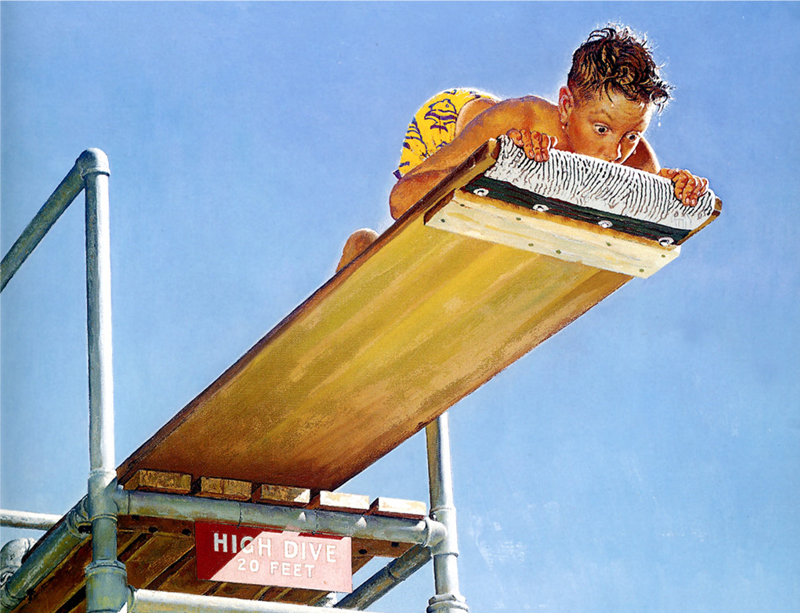Thank You Norman

Norman Rockwell. Love this guy!!.
For those of you who know me best, you already know how much of a little kid I am when it comes to Christmas. I love it all – the lights, the presents, the goodies, going to Mass and celebrating our Lord, putting out cookies for Santa and the time with family and friends. (even the eggnog). I still get all giddy the night before Christmas and wake up extra early on Christmas morning. It will be even more fun this year as a Grandpa, now officially allowed to spoil the dickens out of the next generation. For many years, KHT has featured the amazing work of Norman Rockwell, an American treasure, who could illustrate and paint like no one of his time. A bit idealized at times, there’s still something magical about his work, especially when it comes to capturing the season of Christmas. He had a knack of finding the right pose, the right expressions and the amazement inside all of us. On behalf of the whole gang at KHT, I say Merry Christmas and Happy Chanukah to all – may the good Lord bless you and your families this season, and may the big guy in the red suit bring you joy and happiness again this year. (“and no Rob, you’ll shoot your eye out”). Special thanks to biography.com and the Norman Rockwell museum for the history and use of the images. Enjoy!
Born Norman Percevel Rockwell in New York City on February 3, 1894, Norman Rockwell knew at the age of 14 that he wanted to be an artist, and began taking classes at The New School of Art. By the age of 16, Rockwell was so intent on pursuing his passion that he dropped out of high school and enrolled at the National Academy of Design. He later transferred to the Art Students League of New York. Upon graduating, Rockwell found immediate work as an illustrator for Boys’ Life magazine.
By 1916, a 22-year-old Rockwell, newly married to his first wife, Irene O’Connor, had painted his first cover for The Saturday Evening Post—the beginning of a 47-year relationship with the iconic American magazine. In all, Rockwell painted 321 covers for the Post.
Some of his most iconic covers included the 1927 celebration of Charles Lindbergh’s crossing of the Atlantic. He also worked for other magazines, including Look, which in 1969 featured a Rockwell cover depicting the imprint of Neil Armstrong’s left foot on the surface of the moon after the successful moon landing. In 1920, the Boy Scouts of America featured a Rockwell painting in its calendar. Rockwell continued to paint for the Boy Scouts for the rest of his life.
The 1930s and ’40s proved to be the most fruitful period for Rockwell. In 1930, he married Mary Barstow, a schoolteacher, and they had three sons: Jarvis, Thomas and Peter. The Rockwells relocated to Arlington, Vermont, in 1939, and the new world that greeted Norman offered the perfect material for the artist to draw from.
Rockwell’s success stemmed to a large degree from his careful appreciation for everyday American scenes, the warmth of small-town life in particular. Often what he depicted was treated with a certain simple charm and sense of humor. Some critics dismissed him for not having real artistic merit, but Rockwell’s reasons for painting what he did were grounded in the world that was around him. “Maybe as I grew up and found the world wasn’t the perfect place I had thought it to be, I unconsciously decided that if it wasn’t an ideal world, it should be, and so painted only the ideal aspects of it,” he once said.
Rockwell didn’t completely ignore the issues of the day. In 1943, inspired by President Franklin D. Roosevelt, he painted the Four Freedoms: Freedom of Speech, Freedom of Worship, Freedom from Want and Freedom from Fear. The paintings appeared on the cover of The Saturday Evening Post and proved incredibly popular. The paintings toured the United States and raised in excess of $130 million toward the war effort.
In 1953 the Rockwells moved to Stockbridge, Massachusetts, where Norman would spend the rest of his life.
Following Mary’s death in 1959, Rockwell married a third time, to Molly Punderson, a retired teacher. With Molly’s encouragement, Rockwell ended his relationship with the Saturday Evening Post and began doing covers for Look magazine. His focus also changed, as he turned more of his attention to the social issues facing the country. Much of the work centered on themes concerning poverty, race and the Vietnam War.
In the final decade of his life, Rockwell created a trust to ensure his artistic legacy would thrive long after his passing. His work became the centerpiece of what is now called the Norman Rockwell Museum in Stockbridge.
In 1977—one year before his death—Rockwell was awarded the Presidential Medal of Freedom by President Gerald Ford. In his speech Ford said, “Artist, illustrator and author, Norman Rockwell has portrayed the American scene with unrivaled freshness and clarity. Insight, optimism and good humor are the hallmarks of his artistic style. His vivid and affectionate portraits of our country and ourselves have become a beloved part of the American tradition.”
It is estimated he painted over 4,000 pieces of original art in his lifetime, along with thousands of test paintings. Norman Rockwell died at his home in Stockbridge, Massachusetts, on November 8, 1978.
Watch This!

If you’ve ever been touched by Rockwell’s art, you must spend 46 minutes of your life with this beautifully produced show about his life at Biography.com.


